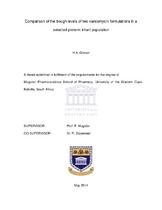| dc.description.abstract | The aim of this study was to compare the trough plasma levels of Aspen-Vancomycin® (AV); and Sandoz-Vancocin CP® (SV) in premature infants with suspected Methicillin Resistant Staphylococcus aureus (MRSA) infection.
The study was designed as a prospective, double blind, randomised trial involving male and female premature infants admitted in the Neonatal Intensive care Unit (NICU) at Netcare Blaauwberg and N1-city Hospitals for treatment of suspected MRSA-infection between April 2012 and June 2013. The inclusion criteria were: 29-35 weeks postmenstrual age (PMA), informed and written consent from parents of each premature infant enrolled in the study. Blood samples (0.3-0.4ml) were collected for renal function test and vancomycin trough levels determination.
Blood samples for vancomycin trough level assay were collected thirty minutes prior to the administration of the third dose of vancomycin. Statistical analysis was performed and estimation was made giving an indication of how many infants will be needed to make the study statistically significant. Wilcoxon Two-Sample test was performed to determine the p-values and Spearman correlation coefficients were used to determine the correlation between trough levels and variables. P-values < 0.05 were considered significant. A total of 19 premature infants met with study criteria, 10 (5 females and 5 males) received AV and 9 (6 females and 3 males) receive d SV. There was no statistical significant difference between the demographic (GA, BW, PMA, PNA, weight at trial entry, height at trial entry) and biological (albumin, serum creatinine concentration and glomerular filtration rate) parameters of the premature infants in the AV and SV group.
There were no statistical significant difference between trough level 1 of AV and SV,
although trough level 1 had a lower trend in the SV group (p=0.118). No AV trough level 1 was below the minimum effective concentration (<5μg/ml). It was found that 30% of AV trough level 1 was within the therapeutic range (5-10μg/ml) and
70% of AV trough level 1, were above minimum toxic concentration (>10mg/l).
It was found that 22.2% of SV trough level 1 was below minimum effective concentration, 44.4% of SV trough level 1 was within therapeutic range and 33.3% of trough level 1 was above minimum toxic concentration. No correlation was found between trough level 1 and the demographic and biological parameters of the premature infants in the AV group. SV had a positive correlation with GA, BBW, PMA and a negative correlation with PNA | en_US |

